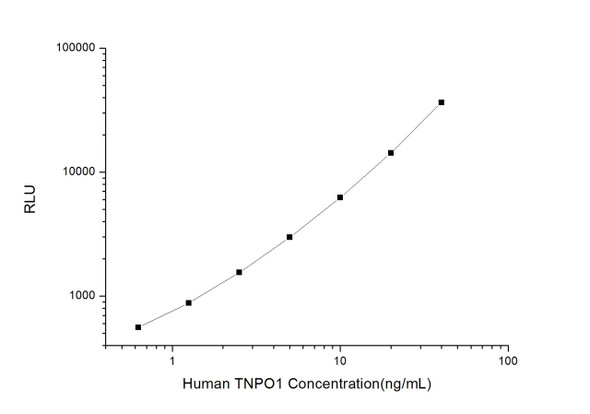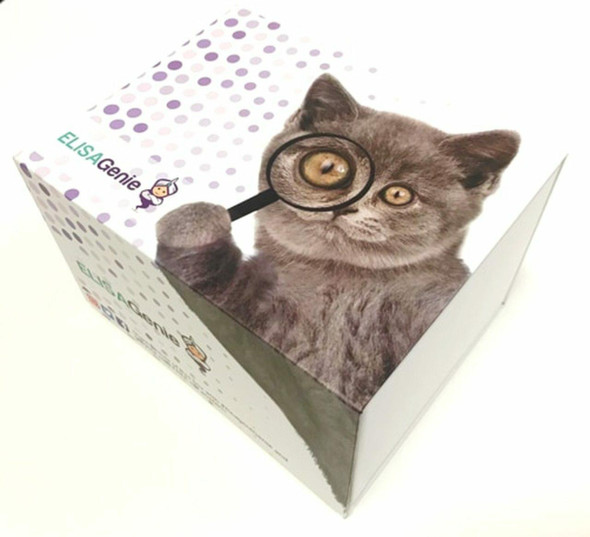Mouse Cell Biology ELISA Kits 2
Mouse TNPO1 (Transportin 1) CLIA Kit (MOES00577)
- SKU:
- MOES00577
- Product Type:
- ELISA Kit
- ELISA Type:
- CLIA Kit
- Size:
- 96 Assays
- Sensitivity:
- 0.19ng/mL
- Range:
- 0.31-20ng/mL
- ELISA Type:
- Sandwich
- Reactivity:
- Mouse
- Sample Type:
- Serum, plasma and other biological fluids
- Research Area:
- Cell Biology
Description
| Assay type: | Sandwich |
| Format: | 96T |
| Assay time: | 4.5h |
| Reactivity: | Mouse |
| Detection method: | Chemiluminescence |
| Detection range: | 0.31-20 ng/mL |
| Sensitivity: | 0.19 ng/mL |
| Sample volume: | 100µL |
| Sample type: | Serum, plasma and other biological fluids |
| Repeatability: | CV < 15% |
| Specificity: | This kit recognizes Mouse TNPO1 in samples. No significant cross-reactivity or interference between Mouse TNPO1 and analogues was observed. |
This kit uses Sandwich-CLIA as the method. The micro CLIA plate provided in this kit has been pre-coated with an antibody specific to Mouse TNPO1. Standards or samples are added to the appropriate micro CLIA plate wells and combined with the specific antibody. Then a biotinylated detection antibody specific for Mouse TNPO1 and Avidin-Horseradish Peroxidase (HRP) conjugate are added to each micro plate well successively and incubated. Free components are washed away. The substrate solution is added to each well. Only those wells that contain Mouse TNPO1, biotinylated detection antibody and Avidin-HRP conjugate will appear fluorescence. The Relative light unit (RLU) value is measured spectrophotometrically by the Chemiluminescence immunoassay analyzer. The RLU value is positively associated with the concentration of Mouse TNPO1. The concentration of Mouse TNPO1 in the samples can be calculated by comparing the RLU of the samples to the standard curve.
| UniProt Protein Function: | KPNB2: Functions in nuclear protein import as nuclear transport receptor. Serves as receptor for nuclear localization signals (NLS) in cargo substrates. Is thought to mediate docking of the importin/substrate complex to the nuclear pore complex (NPC) through binding to nucleoporin and the complex is subsequently translocated through the pore by an energy requiring, Ran- dependent mechanism. At the nucleoplasmic side of the NPC, Ran binds to the importin, the importin/substrate complex dissociates and importin is re-exported from the nucleus to the cytoplasm where GTP hydrolysis releases Ran. The directionality of nuclear import is thought to be conferred by an asymmetric distribution of the GTP- and GDP-bound forms of Ran between the cytoplasm and nucleus. Involved in nuclear import of M9- containing proteins. In vitro, binds directly to the M9 region of the heterogeneous nuclear ribonucleoproteins (hnRNP), A1 and A2 and mediates their nuclear import. Appears also to be involved in hnRNP A1/A2 nuclear export. Mediates the nuclear import of ribosomal proteins RPL23A, RPS7 and RPL5. Binds to a beta-like import receptor binding (BIB) domain of RPL23A. In vitro, mediates nuclear import of H2A, H2B, H3 and H4 histones, and SRP19. In case of HIV-1 infection, binds and mediates the nuclear import of HIV-1 Rev. Belongs to the importin beta family. 3 isoforms of the human protein are produced by alternative splicing. |
| UniProt Protein Details: | Protein type:Nuclear import; RNA-binding; Karyopherin Cellular Component: cytoplasm; nucleus Molecular Function:protein binding; Ran GTPase binding Biological Process: intracellular protein transport; protein transport; transport |
| UniProt Code: | Q8BFY9 |
| NCBI GenInfo Identifier: | 115385968 |
| NCBI Gene ID: | 238799 |
| NCBI Accession: | NP_848831. 2 |
| UniProt Secondary Accession: | Q8BFY9,Q8C0S3, Q8K2E7, |
| UniProt Related Accession: | Q8BFY9 |
| Molecular Weight: | 102,357 Da |
| NCBI Full Name: | transportin-1 isoform 1 |
| NCBI Synonym Full Names: | transportin 1 |
| NCBI Official Symbol: | Tnpo1 |
| NCBI Official Synonym Symbols: | MIP; TRN; IPO2; MIP1; Kpnb2; AU021749; D13Ertd688e |
| NCBI Protein Information: | transportin-1; importin beta-2; karyopherin beta-2; karyopherin (importin) beta 2 |
| UniProt Protein Name: | Transportin-1 |
| UniProt Synonym Protein Names: | Importin beta-2; Karyopherin beta-2 |
| UniProt Gene Name: | Tnpo1 |
| UniProt Entry Name: | TNPO1_MOUSE |
As the RLU values of the standard curve may vary according to the conditions of the actual assay performance (e. g. operator, pipetting technique, washing technique or temperature effects), the operator should establish a standard curve for each test. Typical standard curve and data is provided below for reference only.
| Concentration (ng/mL) | RLU | Average | Corrected |
| 20 | 32899 35065 | 33982 | 33950 |
| 10 | 12162 12778 | 12470 | 12438 |
| 5 | 5251 5249 | 5250 | 5218 |
| 2.5 | 2339 2709 | 2524 | 2492 |
| 1.25 | 1435 1331 | 1383 | 1351 |
| 0.63 | 890 844 | 867 | 835 |
| 0.31 | 617 629 | 623 | 591 |
| 0 | 31 33 | 32 | -- |
Precision
Intra-assay Precision (Precision within an assay): 3 samples with low, mid range and high level Mouse TNPO1 were tested 20 times on one plate, respectively.
Inter-assay Precision (Precision between assays): 3 samples with low, mid range and high level Mouse TNPO1 were tested on 3 different plates, 20 replicates in each plate.
| Intra-assay Precision | Inter-assay Precision | |||||
| Sample | 1 | 2 | 3 | 1 | 2 | 3 |
| n | 20 | 20 | 20 | 20 | 20 | 20 |
| Mean (ng/mL) | 0.99 | 2.40 | 9.64 | 0.93 | 2.33 | 10.24 |
| Standard deviation | 0.10 | 0.22 | 0.94 | 0.12 | 0.18 | 0.99 |
| C V (%) | 10.10 | 9.17 | 9.75 | 12.90 | 7.73 | 9.67 |
Recovery
The recovery of Mouse TNPO1 spiked at three different levels in samples throughout the range of the assay was evaluated in various matrices.
| Sample Type | Range (%) | Average Recovery (%) |
| Serum (n=5) | 88-100 | 95 |
| EDTA plasma (n=5) | 93-108 | 99 |
| Cell culture media (n=5) | 97-115 | 105 |
Linearity
Samples were spiked with high concentrations of Mouse TNPO1 and diluted with Reference Standard & Sample Diluent to produce samples with values within the range of the assay.
| Serum (n=5) | EDTA plasma (n=5) | Cell culture media (n=5) | ||
| 1:2 | Range (%) | 88-102 | 102-117 | 83-99 |
| Average (%) | 95 | 110 | 90 | |
| 1:4 | Range (%) | 91-107 | 94-108 | 96-113 |
| Average (%) | 97 | 101 | 103 | |
| 1:8 | Range (%) | 89-103 | 102-116 | 101-116 |
| Average (%) | 97 | 108 | 109 | |
| 1:16 | Range (%) | 97-113 | 87-99 | 102-117 |
| Average (%) | 104 | 92 | 108 |
An unopened kit can be stored at 4°C for 1 month. If the kit is not used within 1 month, store the items separately according to the following conditions once the kit is received.
| Item | Specifications | Storage |
| Micro CLIA Plate(Dismountable) | 8 wells ×12 strips | -20°C, 6 months |
| Reference Standard | 2 vials | |
| Concentrated Biotinylated Detection Ab (100×) | 1 vial, 120 µL | |
| Concentrated HRP Conjugate (100×) | 1 vial, 120 µL | -20°C(shading light), 6 months |
| Reference Standard & Sample Diluent | 1 vial, 20 mL | 4°C, 6 months |
| Biotinylated Detection Ab Diluent | 1 vial, 14 mL | |
| HRP Conjugate Diluent | 1 vial, 14 mL | |
| Concentrated Wash Buffer (25×) | 1 vial, 30 mL | |
| Substrate Reagent A | 1 vial, 5 mL | 4°C (shading light) |
| Substrate Reagent B | 1 vial, 5 mL | 4°C (shading light) |
| Plate Sealer | 5 pieces | |
| Product Description | 1 copy | |
| Certificate of Analysis | 1 copy |
- Set standard, test sample and control (zero) wells on the pre-coated plate and record theirpositions. It is recommended to measure each standard and sample in duplicate. Note: addall solutions to the bottom of the plate wells while avoiding contact with the well walls. Ensuresolutions do not foam when adding to the wells.
- Aliquot 100µl of standard solutions into the standard wells.
- Add 100µl of Sample / Standard dilution buffer into the control (zero) well.
- Add 100µl of properly diluted sample (serum, plasma, tissue homogenates and otherbiological fluids. ) into test sample wells.
- Cover the plate with the sealer provided in the kit and incubate for 90 min at 37°C.
- Aspirate the liquid from each well, do not wash. Immediately add 100µL of BiotinylatedDetection Ab working solution to each well. Cover the plate with a plate seal and gently mix. Incubate for 1 hour at 37°C.
- Aspirate or decant the solution from the plate and add 350µL of wash buffer to each welland incubate for 1-2 minutes at room temperature. Aspirate the solution from each well andclap the plate on absorbent filter paper to dry. Repeat this process 3 times. Note: a microplatewasher can be used in this step and other wash steps.
- Add 100µL of HRP Conjugate working solution to each well. Cover with a plate seal andincubate for 30 min at 37°C.
- Aspirate or decant the solution from each well. Repeat the wash process for five times asconducted in step 7.
- Add 100µL of Substrate mixture solution to each well. Cover with a new plate seal andincubate for no more than 5 min at 37°C. Protect the plate from light.
- Determine the RLU value of each well immediately.






